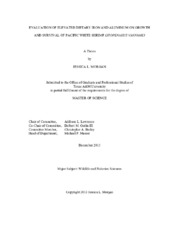| dc.description.abstract | The need to identify economical applications for the co-products of algal biofuel has led to the evaluation of these co-products as feedstuffs in aquaculture feeds. However, the flocculation of algae often results in co-products with high levels of iron (Fe) and aluminum (Al). Two experiments were conducted to evaluate the effects of high levels of dietary Fe and Al on Litopenaeus vannamei. For the first experiment, a semi-purified basal diet was evaluated using ten diets containing graded levels of either Fe or Al at 200, 500, 1,000, 2,000, or 3,000 mg/kg diet over a 30-day period. In the second experiment, 12 diets with either Fe inclusions of 1,650, 3,260, 4,910, 6,640, 8,290 or 10,044 mg/kg diet or Al inclusions of 670, 1,330, 2,000, 2,702, 3,370, or 4,050 mg/kg diet were evaluated over a 42-day period.
The experiments were conducted with post-larval shrimp in 24-L aquaria using a flow-through system. Dissolved oxygen, temperature, and salinity were monitored daily. Automatic feeders distributed diet 15 times daily based on an estimated average growth curve for the duration of both experiments. Feces, molts and uneaten feed were siphoned daily.
Survival was not affected in either experiment by the dietary treatments. In the first experiment, growth and biomass increased with each level of supplemental Fe and Al to the 1,000 mg/kg inclusion. At 2,000 mg/kg inclusion of either Fe or Al, growth and biomass decreased significantly. In the second experiment, growth and biomass significantly decreased with increasing inclusion of either mineral (P<0.0001). In both experiments, body tissues were analyzed to determine mineral retention. In the first experiment, tail muscle and whole-body Fe and Al tissue levels did not increase. However, hepatopancreactic levels significantly increased with increasing dietary levels of both Fe and Al. In the second experiment, retention in tail muscle and combined head and carapace tissues increased significantly with increasing dietary inclusion levels of both Fe and Al.
Based on data from these experiments, relatively high levels of less than 10,000 mg/kg of Fe and Al in co-products are safe assuming a dietary inclusion level of 10% of the co-product. | en |


